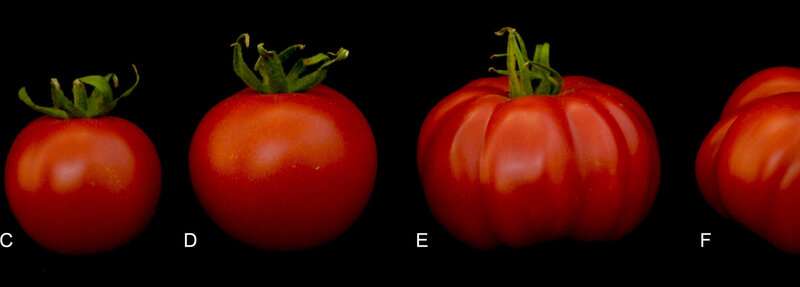March 17, 2020 report
Gene switch ENO identified as a tomato fruit regulator

A team of researchers from Spain, Germany and France has identified the gene switch ENO (excessive number of floral organs) as a tomato fruit regulator. In their paper published in Proceedings of the National Academy of Sciences, the group describes their use of gene sequencing and editing techniques that allowed them to identify the gene switch that is involved in determining fruit size.
Prior research has shown that the modern domestic tomato is considerably larger than its native ancestors—perhaps 100 times as large. The tomato was first domesticated approximately 10,000 years ago in South America and has become a staple in the human diet all around the world. In this new effort, the researchers sought to learn more about the changes the tomato has undergone to allow it to grow to such a large size.
The researchers started with the knowledge that fruit size in tomatoes is determined by the number of carpels in a flower, which lead to the number of seed compartments that grow to become part of the fruit. Prior research has also shown that the actions of both fasciated and locule number mutations account for the development of cultivars that bear more than eight locules. To learn more about other genetic factors that have led to larger fruit, the researchers sequenced the genome of the tomato and also used CRISPR-Cas9 editing to isolate a protein involved in the growth of ENO (a transcription factor that binds to specific DNA sequences). That allowed them to see that ENO is a fruit regulator that is able to do its job by regulating WUSCHEL (a signaling pathway) gene expression resulting in restricting stem cell production in a flower-specific way. They also found that a mutation in the ENO promoter was selected during the long domestication process, which resulted in larger fruit size. More specifically, they found that the mutations in ENO resulted in creating more cavities that house seeds.
The researchers suggest their identification of a gene switch as a regulator of fruit size and its mutations likely explain how the tomato increased in size during domestication.
-

Wild ancestor S. pimpinellifolium (A); semi-domesticated Solanum lycopersicum var. cerasiforme (B); domesticated S. lycopersicum varieties (C-F); lc mutant (D); lc and fas mutant (E); eno mutant (F). Credit: Fernando J. Yuste-Lisbona, Sandra Bretones, and Rafael Lozano -

Representative Flower of Eno Mutant Plant. Credit: Fernando J. Yuste-Lisbona, Antonia Fernández-Lozano, and Rafael Lozano.
More information: Fernando J. Yuste-Lisbona et al. ENO regulates tomato fruit size through the floral meristem development network, Proceedings of the National Academy of Sciences (2020). DOI: 10.1073/pnas.1913688117
Journal information: Proceedings of the National Academy of Sciences
© 2020 Science X Network



















